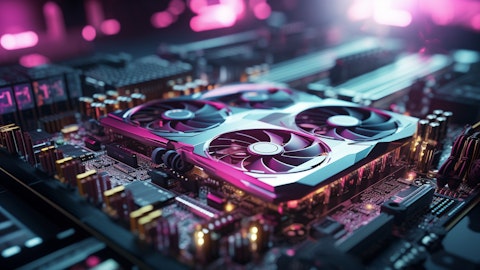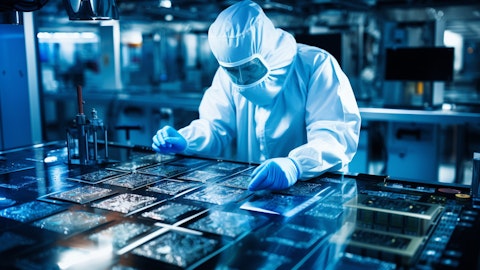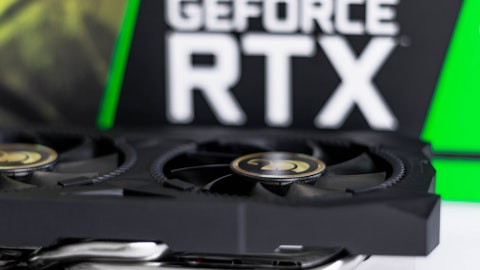And so, the first thing that they have to do is, create their AI cloud, national AI cloud. You’re also seeing us now growing into enterprise. The enterprise market has two paths. One path — or if I could say three paths. The first path, of course, just off-the-shelf AI. And there are of course Chat GPT, a fabulous off-the-shelf AI, there’ll be others. There’s also a proprietary AI, because software companies like ServiceNow and SAP, there are many, many others that can’t afford to have their company’s intelligence be outsourced to somebody else. And they are about building tools and on top of their tools they should build custom and proprietary and domain-specific copilots and assistants that they can then rent to their customer base. This is — they’re sitting on a goldmine, almost every major tools company in the world is sitting on a goldmine, and they recognize that they have to go build their own custom AIs. We have a new service called an AI foundry, where we leverage NVS (ph) capabilities to be able to serve them in that.
And then the next one is enterprises building their own custom AIs, their own custom chatbots, their own custom RAGs. And this capability is spreading all over the world. And the way that we’re going to serve that marketplace is with the entire stacks of systems, which includes our compute, our networking and our switches, running our software stack called NVIDIA AI Enterprise, taking it through our market partners, HP, Dell, Lenovo, so on and so forth. And so we’re just — we’re seeing the waves of generative AI starting from the start-ups and CSPs, moving to consumer Internet companies, moving to enterprise software platforms, moving to enterprise companies. And then ultimately, one of the areas that you guys have seen us spend a lot of energy on has to do with industrial generative AI.
This is where NVIDIA AI and NVIDIA Omniverse comes together and that is a really, really exciting work. And so I think the — we’re at the beginning of a basically across-the-board industrial transition to generative AI to accelerated computing. This is going to affect every company, every industry, every country.
Operator: Your next question comes from the line of Toshiya Hari of Goldman Sachs. Your line is open.
Toshiya Hari: Hi. Thank you. I wanted to clarify something with Colette real quick, and then I had a question for Jensen as well. Colette, you mentioned that you’ll be introducing regulation-compliant products over the next couple of months. Yet, the contribution to Q4 revenue should be relatively limited. Is that a timing issue and could it be a source of reacceleration in growth for Data Center in April and beyond or are the price points such that the contribution to revenue going forward should be relatively limited? And then the question for Jensen, the AI foundry service announcement from last week. I just wanted to ask about that, and hopefully, have you expand on it. How is the monetization model going to work? Is it primarily services and software revenue? How should we think about the long term opportunity set? And is this going to be exclusive to Microsoft or do you have plans to expand to other partners as well? Thank you.
Colette Kress: Thanks, Toshiya. On the question regarding potentially new products that we could provide to our China customers. It’s a significant process to both design and develop these new products. As we discussed, we’re going to make sure that we are in full discussions with the U.S. government of our intent to move products as well. Given our state about where we are in the quarter, we’re already several weeks into the quarter. So it’s just going to take some time for us to go through and discussing with our customers the needs and desires of these new products that we have. And moving forward, whether that’s medium-term or long-term, it’s just hard to say both the [Technical Difficulty] of what we can produce with the U.S. government and what the interest of our China customers in this. So we stay still focused on finding that right balance for our China customers, but it’s hard to say at this time.
Jensen Huang: Toshiya, thanks for the question. There is a glaring opportunity in the world for AI foundry, and it makes so much sense. First, every company has its core intelligence. It makes up our company. Our data, our domain expertise, in the case of many companies, we create tools, and most of the software companies in the world are tool platforms, and those tools are used by people today. And in the future, it’s going to be used by people augmented with a whole bunch of AIs that we hire. And these platforms just got to go across the world and you’ll see and we’ve only announced a few; SAP, ServiceNow, Dropbox, Getty, many others are coming. And the reason for that is because they have their own proprietary AI. They want their own proprietary AI.
They can’t afford to outsource their intelligence and handout their data, and handout their flywheel for other companies to build the AI for them. And so, they come to us. We have several things that are really essential in a foundry. Just as TSMC as a foundry, you have to have AI technology. And as you know, we have just an incredible depth of AI capability — AI technology capability. And then second, you have to have the best practice known practice, the skills of processing data through the invention of AI models to create AIs that are guardrails, fine-tuned, so on and so forth, that are safe, so on and so forth. And the third thing is you need factories. And that’s what DGX Cloud is. Our AI models are called AI Foundations. Our process, if you will, our CAD system for creating AIs are called NeMo and they run on NVIDIA’s factories we call DGX Cloud.





